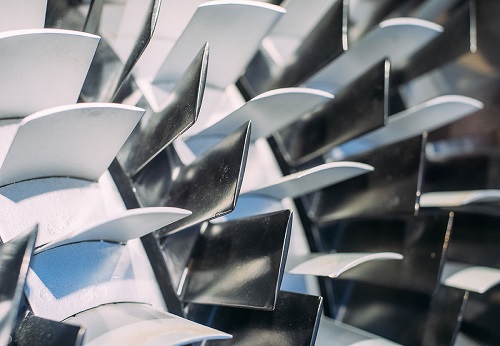Thermal Management in Aerospace Applications
The push for cleaner skies and the rising cost of fuel is driving aerospace manufacturers to seek more efficient turbine engines. As combustion temperatures rise, efficiencies increase, and emissions of nitrogen oxides and carbon dioxide fall as engines burn fuel more completely. Developing materials that can operate at these intense temperatures has been the focus of R&D for several years now.
In a commercial jet engine, the fuel burns at up to 2000°C in the combustion chamber [1]. The turbine, which extracts energy from the hot gases and provides the engine power, is exposed to gases at between 850-1700°C. Yet increasing engine efficiency means increasing the temperature in the turbine inlet even further. The turbine blades need to be able to work and withstand long operating periods at these temperatures that are above their melting point.
Thermal Barrier Coatings
The best way to protect turbine blades from this extreme heat is to use thermal barrier coatings (TBC). TBC systems consist of an insulating ceramic top coat applied over a metallic bond coat. A thermally grown oxide forms between these two layers [2].

Ceramics are used in the top coat because they tend to have higher melting points than metal and low thermal conductivity. As the ceramic does not conduct the heat of the gas, the temperature of the blade alloy remains stable. The result is that the turbine can run at higher temperatures, and efficiency to increase [3].
The most commonly used ceramic is zirconia. In most cases, zirconium oxide (ZrO2) is stabilized with yttrium oxide (Y2O3) [4]. This combination has a very low thermal conductivity. The ceramic is applied in layers 250 -375µm thick, and a complex alloy plating (the bond coat) is used to stick it to the turbine blade alloy. This oxidation-resistant metallic bond coat also helps reduce heat transfer to the base material.
In summary, TBCs reduce the temperature of the blade alloy and protect against oxidation and hot corrosion from high-temperature gas [2]. This means that turbine performance, life expectancy, and efficiency are all significantly improved.
Coating Solutions for the Aerospace Industry
Saint-Gobain Coating Solutions manufactures a wide range of technically superior thermal barrier coatings in the form of thermal spray powders and EB-PVD ingots. Using its expertise in materials technology and process engineering, it can deliver the best solution to protect equipment, such as turbine blades, against high-temperature erosion, abrasion, oxidation, and wear. Most importantly, its products ensure longer service life and improved performance in extreme environments.
With its sophisticated process technology, Saint-Gobain can provide uniform chemistry and particle size control for completely homogenous powders. For each specific application, its team will tailor powder chemistry and particle size based on the demands of equipment and properties of the desired coatings. This ability to tune the morphology, material homogeneity, and purity to the customer’s needs results in maximum deposit efficiency and optimal coating performance.
Thermal Spray Powders
Saint-Gobain manufactures a range of zirconia-based thermal spray powders for TBC with the key features of low thermal conductivity and long coating lifespan. They have excellent wear-resistant properties for high-temperature applications such as gas turbines and combustion engines.
The company’s yttria zirconia powders contain very few impurities and tightly controlled particle size and morphology. These characteristics lead to high deposit efficiency while spraying and extended coating life during use. With their particularly low thermal conductivity, they are highly resistant to thermal shock, erosion, and corrosion in high-temperature applications.
The company offers a range of formulations and particle sizes such as the 204 Series which features 8% stabilized yttria, and exhibits exceptional mechanical toughness. These have a very uniform chemistry and are available in a range of particle sizes to meet specific porosity demands. The spherical shape of the 204 powder means more uniform delivery of the powder without plugging or pulsing of feed lines. The hollow particles yield more complete melting, which further increases deposit efficiency. The 204 PR series is recommended to achieve higher levels of porosity while the 204F series is tailored for dense coatings.
The 202 powder series however, is a highly homogenous, hollow sphere powder containing 20% yttria. It provides excellent thermal barrier protection in air engine applications with lower thermal conductivity than the 8% partially stabilized yttria zirconia.
The 1190 series is another hollow-sphere, high-purity powder producing very reliable coatings. They provide the lowest thermal conductivity for an extremely durable TBC and have an excellent stress/strain response. They have no monoclinic crystal phase and silica levels are usually less than 0.1%.
The above mentioned features of morphology, shape, and purity can be offered in customized compositions according to customer requirements.
Environmental Barrier Coating Powders (EBC’s)
EBCs protect engine parts against erosion and corrosion from gases and water vapor. Saint-Gobain provides high-purity rare earth silicates and barium strontium aluminium silicate (BSAS) thermal spray powders [6].
Aerospace manufacturers demand high-purity environmental barrier protection. Rare earth powders can be used to protect silicon carbide parts from gas erosion, and the company can tailor their chemistry and size to meet specific requirements. Examples of advanced EBC powders include yttrium monosilicate and yttrium disilicate. BSAS is an important coating used to seal the base material from high-temperature water vapor and other corrosive gases found in gas turbines. Rare earth silicates are used with BSAS to slow down gas penetration.
Ingots for Thermal Barrier Coatings
Saint-Gobain’s EB-PVD ingots are made from the legacy yttria-stabilized zirconia [7] or any customized advanced TBC. Rigorous quality control standards at the production stage are key to an unparalleled reliability. Dedicated production equipment ensures that each ingot produced has uniform density and morphology from lot to lot. To make sure that each ingot can be traced from raw material to final product, the company undertakes wide-ranging testing of materials, systems, and processes. The ingots have very high-stress compliance and excellent surface finish.
References
[1] https://cs.stanford.edu/people/eroberts/courses/ww2/projects/jet-airpla…
[2] https://www.hindawi.com/journals/mpe/2017/2147830/
[3] https://awamdhlwmaterialsengineers.wordpress.com/2014/12/01/thermal-bar…
[4] http://iieng.org/images/proceedings_pdf/IAE0716412.pdf
[5] https://www.coatingsolutions.saint-gobain.com/materials/thermal-spray-p…
[6] https://www.coatingsolutions.saint-gobain.com/materials/thermal-spray-p…
[7] https://www.coatingsolutions.saint-gobain.com/materials/eb-pvd-ingots-y…
